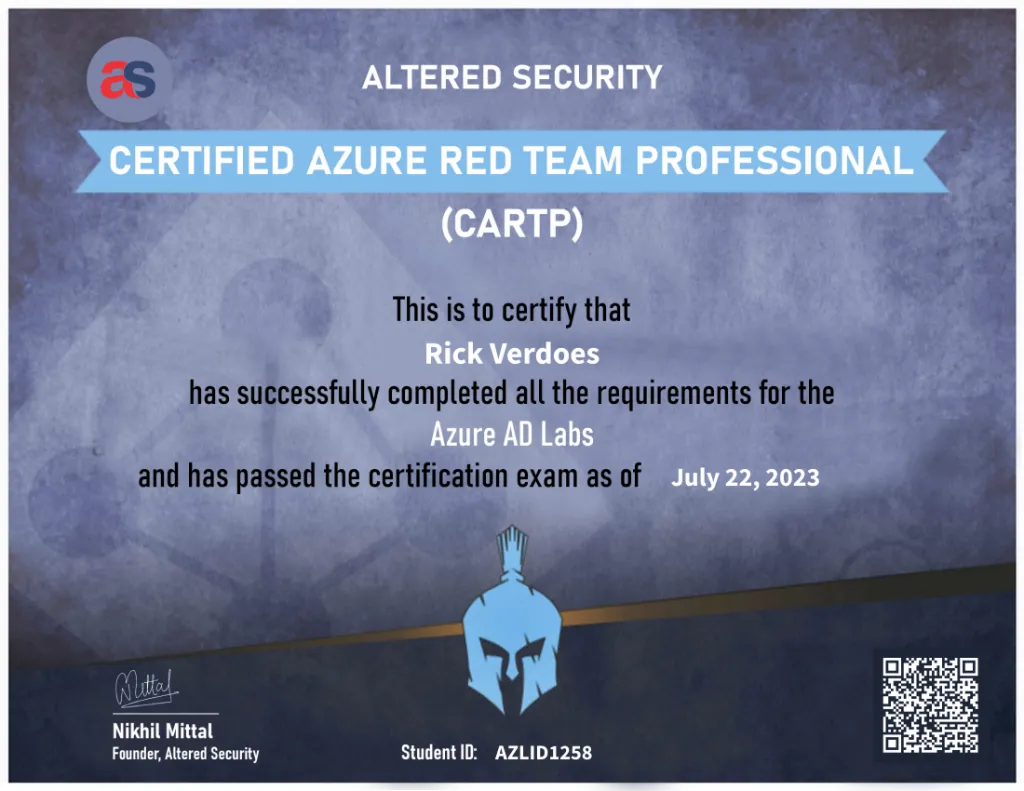Wij zijn |
Certified Azure Red Team Professional (CARTP) review
As a cybersecurity professional, I had a basic understanding of Azure and its functionalities. However, I had never delved deep into its security aspects. Recognizing the growing importance of Azure security in the industry, I decided to expand my knowledge and skills in this area. This led me to enroll in the Certified Azure Red Team Professional (CARTP) certification offered by Altered Security (former Pentester Academy).
The CARTP certification is a designed to provide an in-depth understanding of Azure security, focusing on Azure and Azure AD’s potential risks. The course is structured around multiple complex kill chains/attacking paths against a lab containing multiple live Azure tenants with simulated user interactions, covering all phases of Azure red teaming and pentesting.
Certified Az Red Team Professional (CARTP) review
The course
The course content is delivered in a manner consistent with other courses from Altered Security, which I was already familiar with from my Certified Red Team Professional (CRTP) course. The course is a mix of lectures, demos, exercises, and hands-on practice, with a strong focus on methodology and techniques rather than specific tools.
The course embodies a hands-on learning experience. Each newly introduced concept is immediately put to the test in a lab environment, reinforcing understanding and application. The course is designed in such a way that each task has a specific objective – to find a ‘flag’. These flags, once found, can be submitted to an online portal. This portal not only validates the successful completion of the task but also serves as a progress tracker, allowing me to monitor my advancement throughout the course. This immediate feedback loop of learning, applying, and validating enhances the overall learning experience, making the course both engaging and effective.
During the course, in addition to the materials provided by Altered Security, I found the cheat sheet by 0xJs to be a great resource. This cheat sheet, available on GitHub, is specifically designed for the CARTP course and covers a wide range of topics including general information, reconnaissance, initial access attacks, authenticated enumeration, privilege escalation, lateral movement, and persistence.
Exam
The exam is a 24-hour practical test, designed to evaluate the knowledge and skills you’ve gained during the course. It’s focused on Azure-related complexities and requires you to compromise all resources and retrieve the final flag. Following the hands-on part of the exam, you have an additional 48 hours to write and submit a comprehensive report.
In the exam environment, no tools are provided in advance. So, I advise having all your tools ready and set up in advance before diving into the exam.
Conclusion
The CARTP course is an invaluable asset for any security professional looking to enhance their skills in Azure AD security and learn how to pentest it. The course imparts a thorough understanding of Azure-based attacks, and the live lab environment offers a unique opportunity to apply the learned skills in a realistic setting. The course is challenging yet fair, ensuring that students have a comprehensive understanding of Azure security by the end of it.
Hoe kunnen wij u helpen?
QR Codes: Het onverwachte wapen in Device Code Phishing
Device code phishing, net als aanvallen via Adversary-in-the-middle (AiTM), vertegenwoordigt een geavanceerde vorm van cyberdreiging die zich onderscheidt van traditionele phishing. Device code phishing exploiteert de ‘OAuth2 Device Authorization Grant flow‘ van Microsoft Azure, die gebruikers in staat stelt zich aan te melden bij apparaten met beperkte invoermogelijkheden.
Cross-Site Scripting (XSS): wat is het en hoe te voorkomen
In deze blogpost lees je alles over Cross-Site Scripting (XSS). Welke vormen van XSS er zijn. Wat de impact van een XSS-aanval kan zijn en hoe je het kan voorkomen.
CORS: het belang van Cross-Origin Resource Sharing
Bij onze klanten zien we een toenemende implementatie van Cross-Origin Resource Sharing (CORS). Helaas constateren we ook een stijging in het aantal onveilig geconfigureerde CORS-implementaties. In deze blog duiken we dieper in wat CORS is, de meest voorkomende misconfiguraties en hun potentiële risico’s, en hoe je sterke CORS-regels kunt instellen om je webapplicaties te beschermen.







